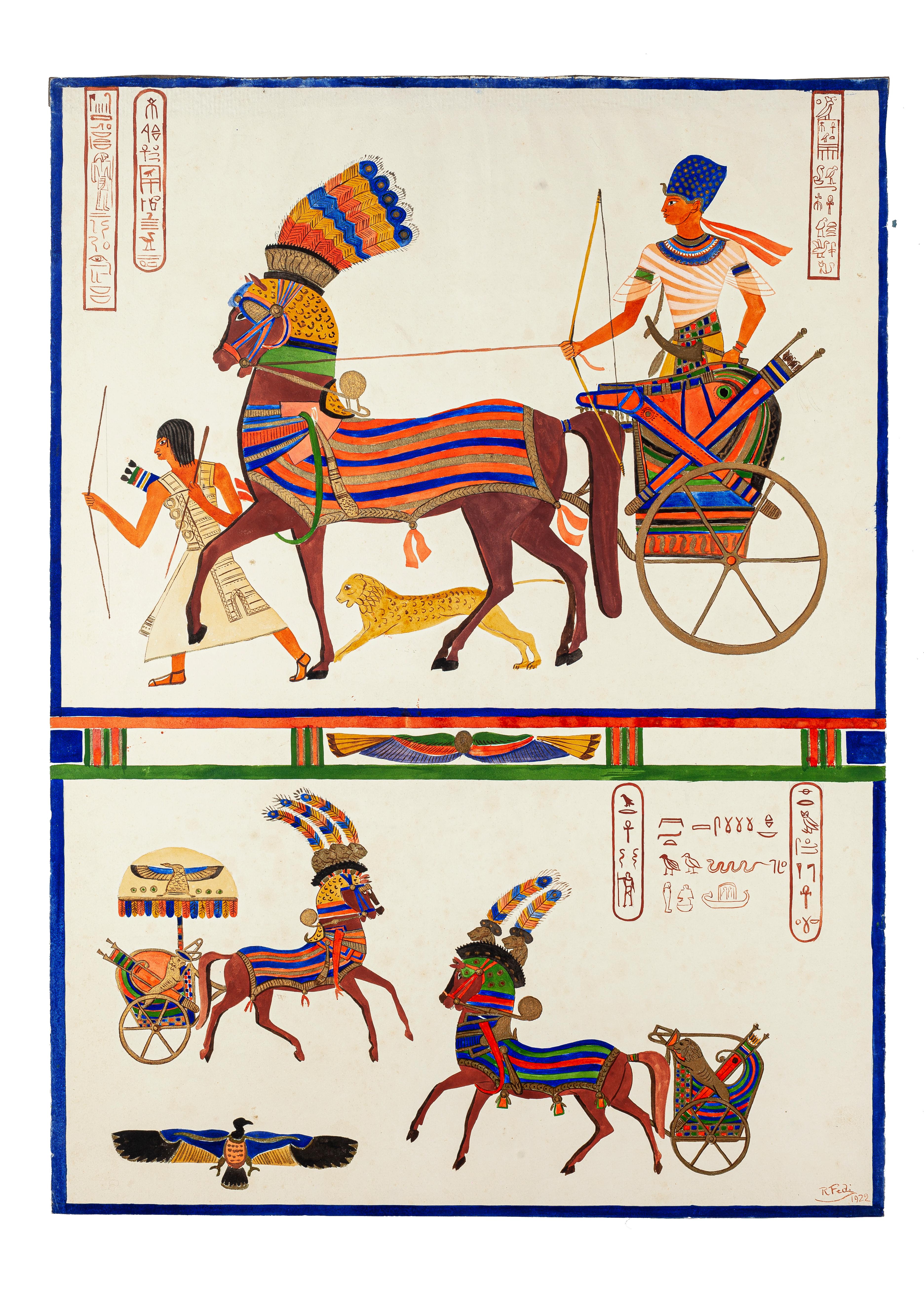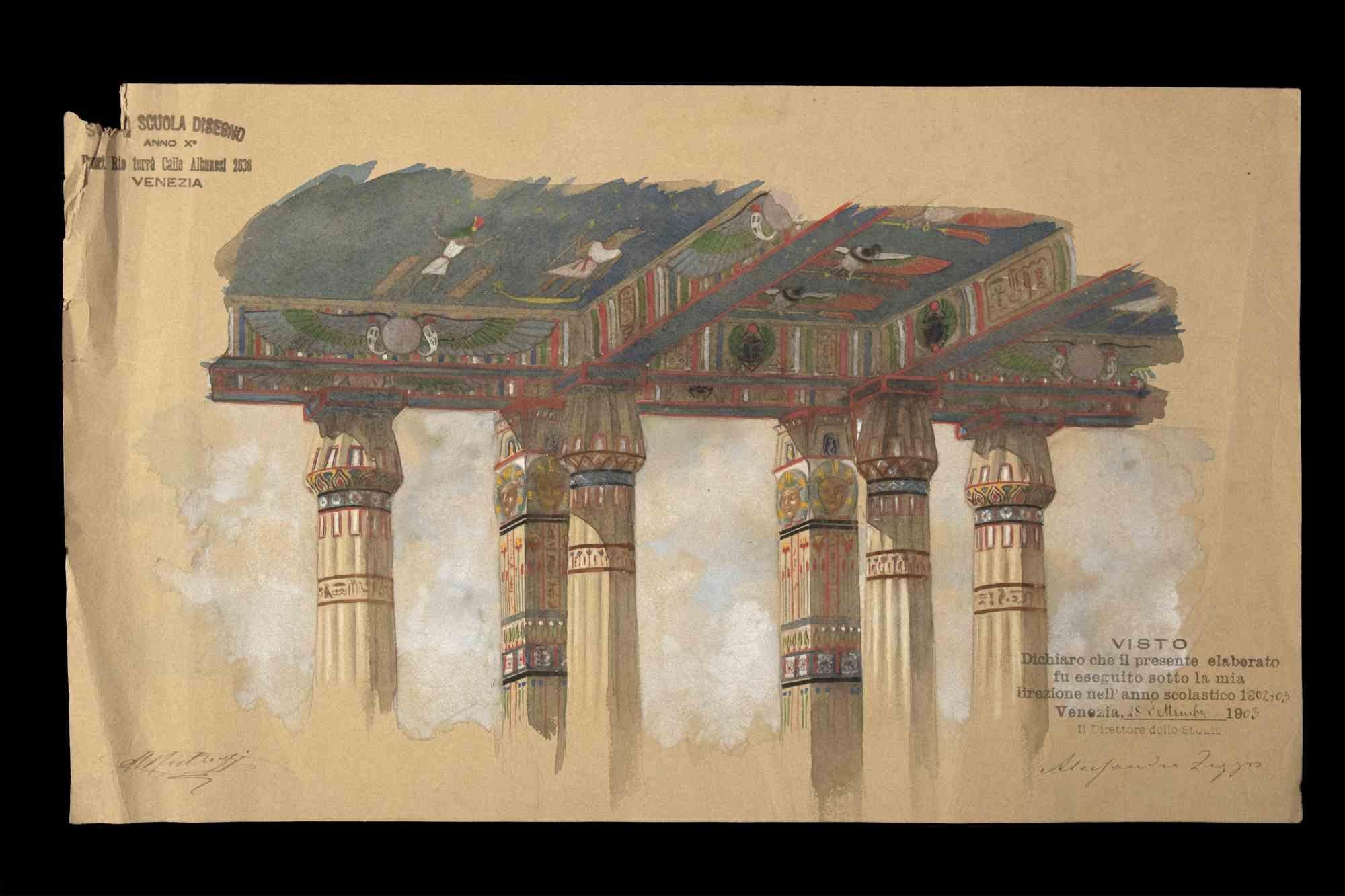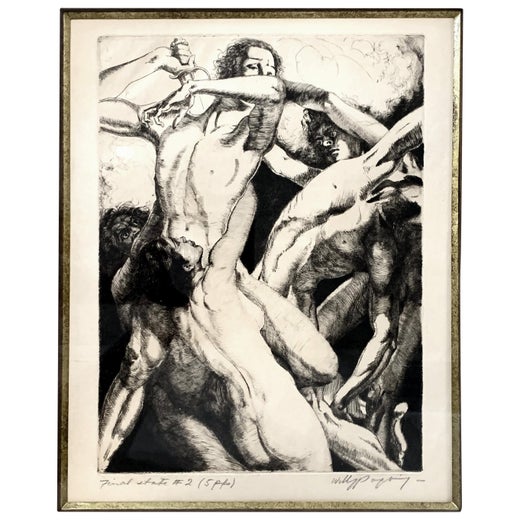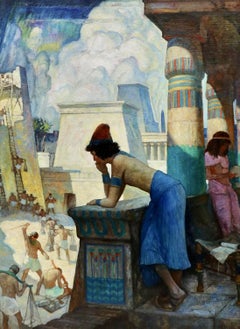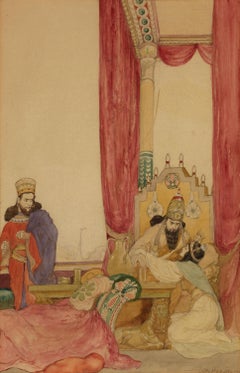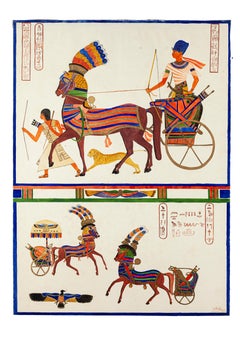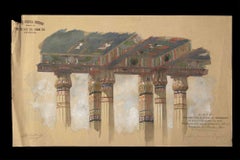Items Similar to Nero's Temple On The Nile
Want more images or videos?
Request additional images or videos from the seller
1 of 8
Willy PoganyNero's Temple On The Nile1947
1947
$9,000
£6,801
€7,853.49
CA$12,576.14
A$13,954.29
CHF 7,309.56
MX$171,117.04
NOK 92,975.04
SEK 87,764.47
DKK 58,568.40
Shipping
Retrieving quote...The 1stDibs Promise:
Authenticity Guarantee,
Money-Back Guarantee,
24-Hour Cancellation
About the Item
Medium: Gouache on Illustration Board
Signature: Signed Middle Right
Sight Size 20.50" x 27.00;" Framed 30.25" x 35.00"
Framed and matted under glass in antique gold painted art deco frame
A large and important bustling published colorful gouache illustration painting by Willy Pogany for an interior story titled "Nero's Temple On The Nile", which appeared in the January 12, 1947 edition of Randolph Hearst's American Weekly Magazine. An over the top opulant Egyptian themed costumed imagining of life in ancient Rome, which appeared with the following story caption: "Feeling some remorse for his sinful past, or astutely making a political gesture to gratify his restive subjects, Nero apparently caused the temple to be rebuilt and then worshipped at its shrine." Artists that worked for this long running syndicated newspaper Sunday supplement included Henry Clive, Edmund Dulac, Victor Tchetchet, Mario Cooper and Willy Pogany.
William Andrew (Willy) Pogany was a native of Hungary and his first studies in Budapest and Paris were in engineering. Success in caricaturing led him to pursue and art career, first in London and then in America. His influences were the Oriental artists and illuminated books, and much of his career was devoted to book illustration.
Among his many successes were The Rubaiyat, The Kasidah, The Children’s Book of Northern Myths, The Witch’s Kitchen, The Frenzied Prince, Sonnets from the Portuguese, Fairy Flowers, Forty-Four Turkish Fairy Tales, Tales of the Persian Genii, A Treasury of Verse for Little Children, Stories to Tell the Littlest Ones, Hungarian Fairy Book, and Gulliver’s Travels. He also painted murals, did etchings, designed stage settings, and exhibited widely, the artist was also a favorite in Randolph Hearst’s magazines.
- Creator:Willy Pogany (1882 - 1955, Hungarian)
- Creation Year:1947
- Dimensions:Height: 20.5 in (52.07 cm)Width: 27 in (68.58 cm)
- Medium:
- Period:
- Condition:
- Gallery Location:Fort Washington, PA
- Reference Number:Seller: 35151stDibs: LU38435783952
Willy Pogany
Willy Pogany was born and educated in Hungary, before emigrating to Great Britain and then leaving again for New York after World War I. He studied at Budapest Technical University and in Munich and Paris. Pogany spent his early childhood with his brothers and sisters in a large farmhouse full of chickens, ducks, geese, dogs, pigs and horses. He became one of the nation's leading book illustrators, leaving his imprint on a wide range of books such as A Treasury of Verse for Little Children, The Rubaiyat of Omar Khayyam and The Rime of the Ancient Mariner.
About the Seller
5.0
Recognized Seller
These prestigious sellers are industry leaders and represent the highest echelon for item quality and design.
Platinum Seller
Premium sellers with a 4.7+ rating and 24-hour response times
Established in 1995
1stDibs seller since 2016
127 sales on 1stDibs
Typical response time: 4 hours
- ShippingRetrieving quote...Shipping from: Fort Washington, PA
- Return Policy
Authenticity Guarantee
In the unlikely event there’s an issue with an item’s authenticity, contact us within 1 year for a full refund. DetailsMoney-Back Guarantee
If your item is not as described, is damaged in transit, or does not arrive, contact us within 7 days for a full refund. Details24-Hour Cancellation
You have a 24-hour grace period in which to reconsider your purchase, with no questions asked.Vetted Professional Sellers
Our world-class sellers must adhere to strict standards for service and quality, maintaining the integrity of our listings.Price-Match Guarantee
If you find that a seller listed the same item for a lower price elsewhere, we’ll match it.Trusted Global Delivery
Our best-in-class carrier network provides specialized shipping options worldwide, including custom delivery.More From This Seller
View All"The Boy, Moses" illustration for Children of the Bible in Good Housekeeping
By Newell Convers Wyeth
Located in Fort Washington, PA
The present work was reproduced as an illustration for Bruce Barton's story "The Boy Who Established a Nation," published in the February 1929 issue of Good Housekeeping. Part of an ...
Category
1920s Figurative Paintings
Materials
Canvas, Oil
The Holy Temple, Biblical Illustration
By Maurice L. Bower
Located in Fort Washington, PA
Medium: Oil on Board
Dimensions: 18.00" x 14.00"
Signature: Signed Lower Left
Biblical illustration.
Category
20th Century Figurative Paintings
Materials
Oil, Board
Esther Accusing Haman
By Willy Pogany
Located in Fort Washington, PA
Story illustration for "Queen Esther's Feast," published in the book Bible Stories to Read and Tell: 150 Stories from the Old Testament with References to the Old and New Testaments,...
Category
20th Century Drawings and Watercolor Paintings
Materials
Paper, Watercolor
The Slave Market, Book Illustration for "The Robe" by Lloyd Douglas
By Dean Cornwell
Located in Fort Washington, PA
Story illustration for The Robe (People's Book Club) written by Lloyd Douglas, 1942
"Father had bought Demetrius six years ago and presented him to Marcellus on his seventeenth birt...
Category
1940s Figurative Paintings
Materials
Canvas, Oil
1948 Presentation of Israel's Habima Company of "The Dybbuk" in rep with "D
By George Wachsteter
Located in Fort Washington, PA
Medium: Pen and Ink on Illustration Board
Signature: Signed Lower Right
This piece is on 15.00" x 20.00" illustration board, with an image that measures to 12.00" x 17.00."
Drawing by George Wachsteter (1911-2004) for 1948 Broadway presentation by Israel`s Habima Company of `The Dybbuk...
Category
1940s Figurative Drawings and Watercolors
Materials
Ink, Illustration Board, Pen
Blood of my Blood – The Sacrifice
By Henry Soulen
Located in Fort Washington, PA
Medium: Oil on Board
Signature: Signed Lower Left
Illustration for “Blood of my Blood – The Sacrifice”, published in Ladies Home Journal, April 1930, page 4.
Category
1930s Figurative Paintings
Materials
Oil, Board
You May Also Like
Ancient Egypt - Watercolor by R. Fedi - Early 20th Century
Located in Roma, IT
Ancient Egypt is an drawing in watercolor on cardboard realized by R. Fedi in 1922.
The state of preservation of the artwork is very good.
Hand-signed on the lower right and dated....
Category
1920s Figurative Drawings and Watercolors
Materials
Watercolor
Egyptian Temple - Chromolithograph by A. Alessio - Early 20th Century
Located in Roma, IT
Egyptian Temple is a print on ivory-colored paper realized by A. Alessio in the early 20th Century. Signed on the plate on the lower.
.
Vintage Chromolit...
Category
Early 20th Century Modern Figurative Prints
Materials
Lithograph
Interior of the Great Temple of Aboo Simbel - Orientalist - David Roberts
By David Roberts
Located in London, GB
David Roberts R.A.
1796 - 1864
Interior of the Great Temple of Aboo Simbel
Subscription edition and First edition lithographs available
Full plate: 139
Acid free mount
With David ...
Category
19th Century Victorian Interior Prints
Materials
Lithograph
Sketch of Egyptian Temple - Original Pastel Drawing - Early 20th Century
Located in Roma, IT
Sketch of Egyptian Temple is an original drawing in watercolor and Ink realized by an anonymous artist in the early 20th Century.
Good conditions except ...
Category
Early 20th Century Modern Figurative Drawings and Watercolors
Materials
Pastel
View From Under The Portico of The Temple of Edfou, Upper Egypt
By David Roberts
Located in London, GB
David Roberts R.A.
1796 - 1864
VIEW FROM UNDER THE PORTICO OF THE TEMPLE OF EDFOU, UPPER EGYPT
First edition lithograph available
Full plate: 157
Presented in an acid free mount
We have in stock a full set of the David Roberts lithographs...
Category
Mid-19th Century Landscape Prints
Materials
Lithograph
Study for Scenograpy on Ancient Egypt - Drawing - Early 20th Century
Located in Roma, IT
Study for Scenograpy on Ancient Egypt is an original Ink and Watercolor Drawing realized by an unknown artist in the early-20th century.
Very good condition on a yellowed paper.
No...
Category
Early 20th Century Modern Figurative Drawings and Watercolors
Materials
Watercolor, Ink
More Ways To Browse
Political Illustrations
Vintage Illustration Children
Fairy Drawing
The Little Prince
Middle Temple
William Temple
Vintage Engineering Drawings
Nile Painting
Fairy Book
Fairy Tale Illustration
Witch Painting
Vintage Running Board
Gullivers Travels
Somers Randolph
Henry Clive Painting
Sonnets From The Portuguese
British Landscape Artists
Picasso Vintage Print
